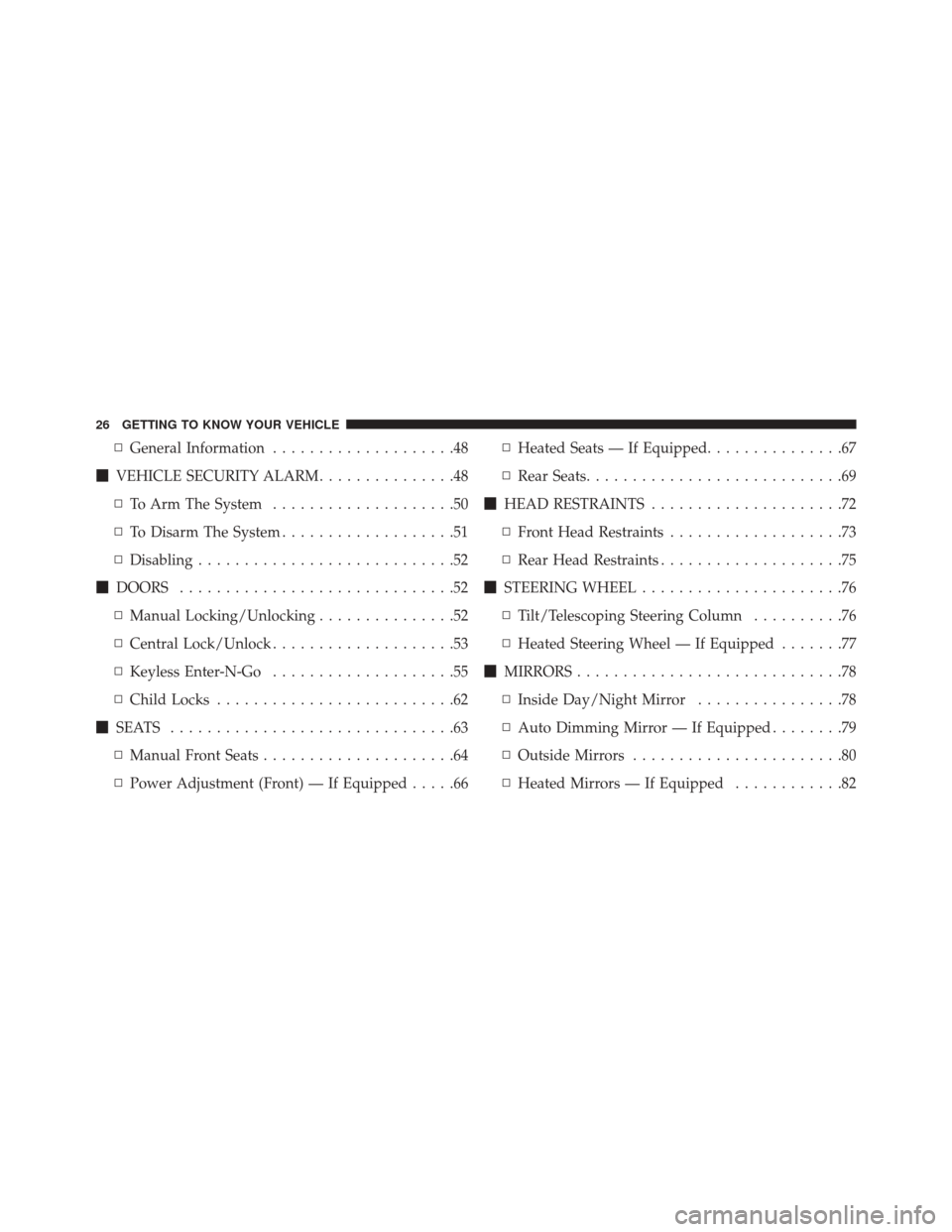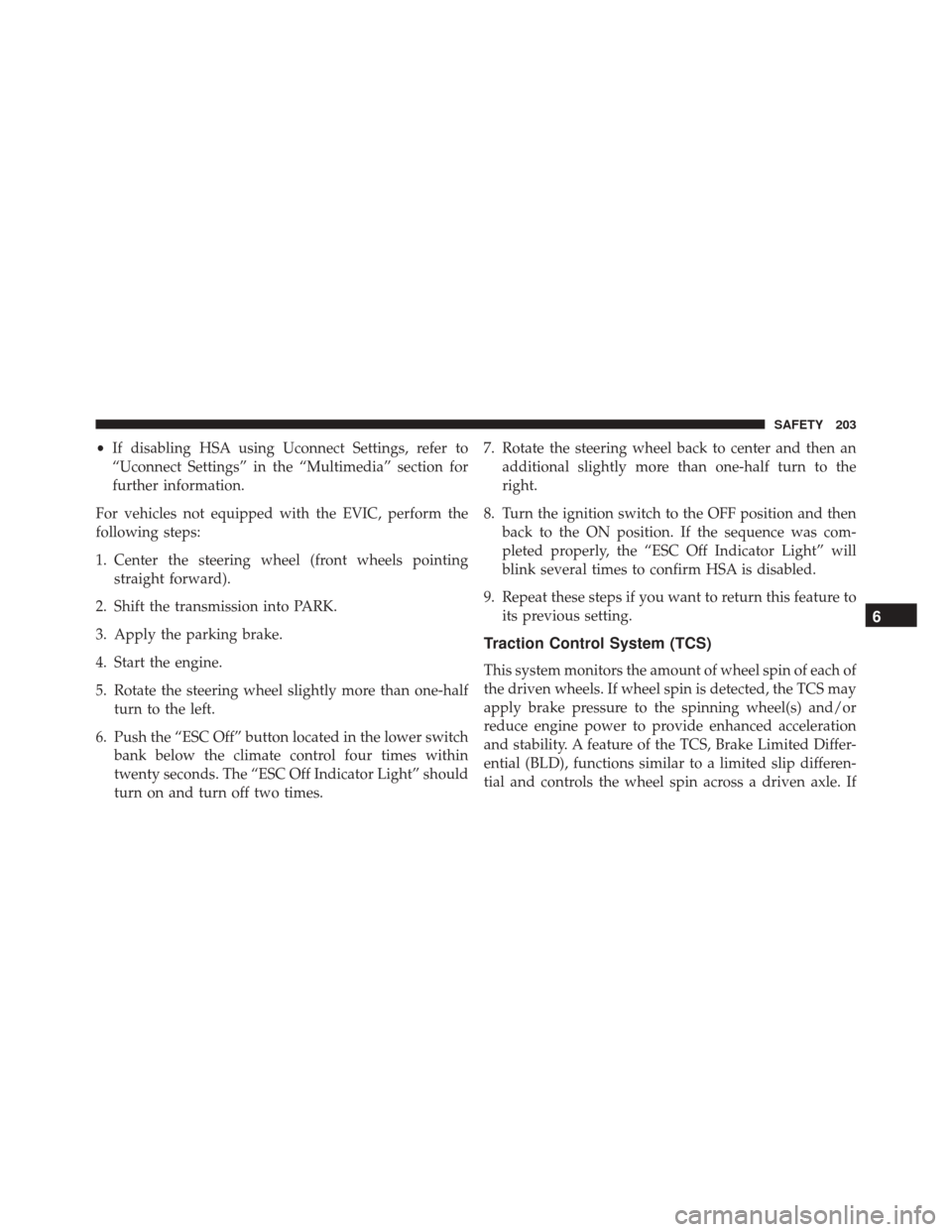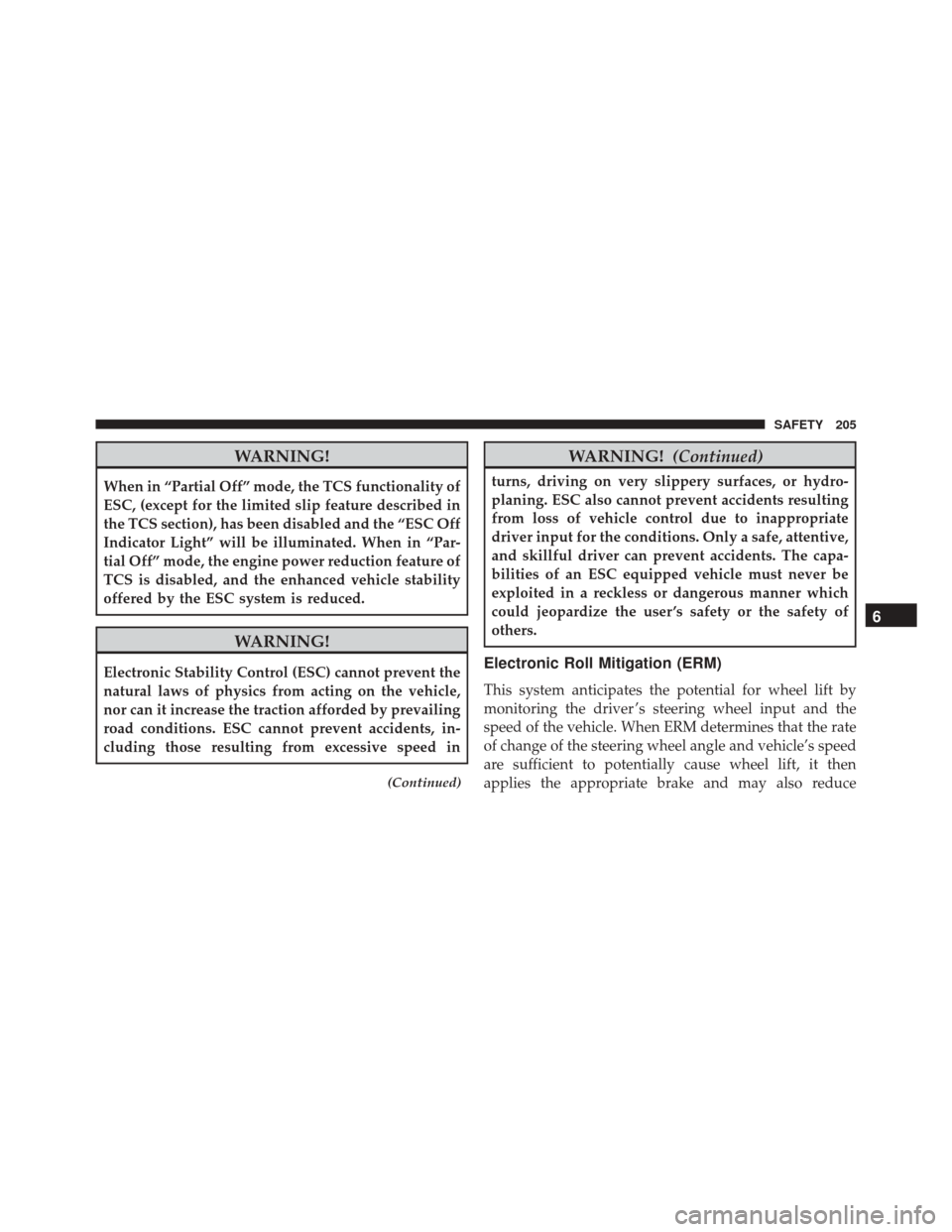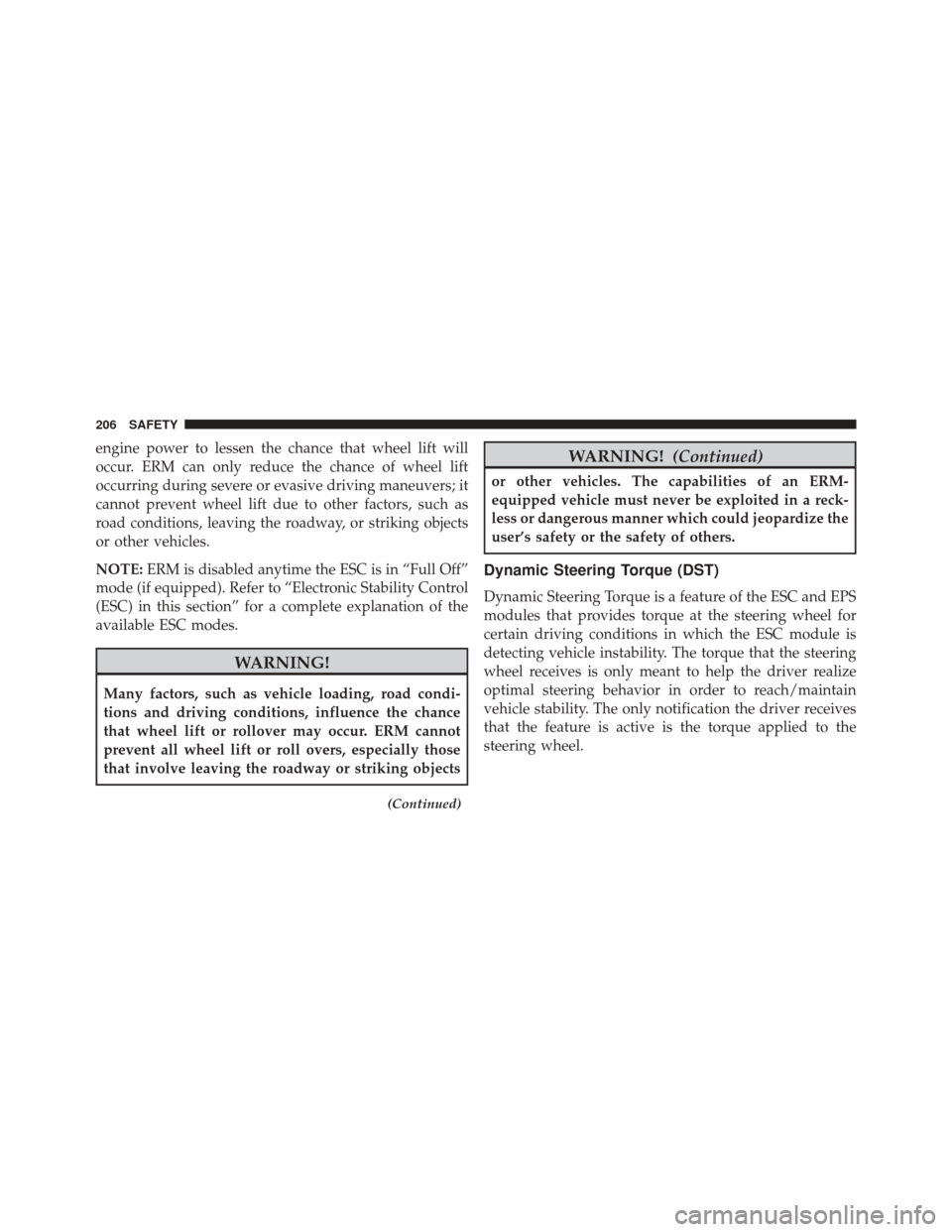Page 28 of 587

▫General Information ....................48
� VEHICLE SECURITY ALARM ...............48
▫ To Arm The System ....................50
▫ To Disarm The System ...................51
▫ Disabling ............................52
� DOORS ..............................52
▫ Manual Locking/Unlocking ...............52
▫ Central Lock/Unlock ....................53
▫ Keyless Enter-N-Go ....................55
▫ Child Locks ..........................62
� SEATS ...............................63
▫ Manual Front Seats .....................64
▫ Power Adjustment (Front) — If Equipped .....66▫
Heated Seats — If Equipped ...............67
▫ Rear Seats ............................69
� HEAD RESTRAINTS .....................72
▫ Front Head Restraints ...................73
▫ Rear Head Restraints ....................75
� STEERING WHEEL ......................76
▫ Tilt/Telescoping Steering Column ..........76
▫ Heated Steering Wheel — If Equipped .......77
� MIRRORS .............................78
▫ Inside Day/Night Mirror ................78
▫ Auto Dimming Mirror — If Equipped ........79
▫ Outside Mirrors .......................80
▫ Heated Mirrors — If Equipped ............82
26 GETTING TO KNOW YOUR VEHICLE
Page 41 of 587
•The key can be removed from the ignition.
• The steering column can be locked (with the ignition
key removed).
• Some electrical devices (e.g. power locks, alarm, etc.)
are still available.
2 — MAR/RUN
• Driving position.
• Electrical devices are available.
3 — AVV/START
• Start the engine.
The ignition switch is provided with a safety mechanism.
If the engine fails to start, the ignition will return to the
STOP/OFF position prior to repeating the starting pro-
cedure. On models equipped with an automatic transmission, the
ignition key is only removable when the shift lever is in
PARK.
Electronic Key
This Keyless Enter-N-Go system feature allows the driver
to operate the ignition switch with the push of a button as
long as the Remote Keyless Entry (RKE) transmitter is in
the passenger compartment.
The Keyless Push Button Ignition has three operating
positions. The three positions are STOP, RUN, and
START.4
GETTING TO KNOW YOUR VEHICLE 39
Page 195 of 587
Power Steering System Warning•What Does It Mean
This light will illuminate to indicate a fail-
ure in the Electronic Power Steering System
(EPS). Although it will still be possible to
steer the car, additional effort may be needed to
operate the steering wheel.
• What To Do
Please contact an authorized dealer as soon as pos-
sible.
5
GETTING TO KNOW YOUR INSTRUMENT CLUSTER 193
Page 205 of 587

•If disabling HSA using Uconnect Settings, refer to
“Uconnect Settings” in the “Multimedia” section for
further information.
For vehicles not equipped with the EVIC, perform the
following steps:
1. Center the steering wheel (front wheels pointing straight forward).
2. Shift the transmission into PARK.
3. Apply the parking brake.
4. Start the engine.
5. Rotate the steering wheel slightly more than one-half turn to the left.
6. Push the “ESC Off” button located in the lower switch bank below the climate control four times within
twenty seconds. The “ESC Off Indicator Light” should
turn on and turn off two times. 7. Rotate the steering wheel back to center and then an
additional slightly more than one-half turn to the
right.
8. Turn the ignition switch to the OFF position and then back to the ON position. If the sequence was com-
pleted properly, the “ESC Off Indicator Light” will
blink several times to confirm HSA is disabled.
9. Repeat these steps if you want to return this feature to its previous setting.
Traction Control System (TCS)
This system monitors the amount of wheel spin of each of
the driven wheels. If wheel spin is detected, the TCS may
apply brake pressure to the spinning wheel(s) and/or
reduce engine power to provide enhanced acceleration
and stability. A feature of the TCS, Brake Limited Differ-
ential (BLD), functions similar to a limited slip differen-
tial and controls the wheel spin across a driven axle. If
6
SAFETY 203
Page 206 of 587

one wheel on a driven axle is spinning faster than the
other, the system will apply the brake of the spinning
wheel. This will allow more engine torque to be applied
to the wheel that is not spinning. BLD may remain
enabled even if TCS and ESC are in a reduced mode.
Electronic Stability Control (ESC)
This system enhances directional control and stability of
the vehicle under various driving conditions. ESC cor-
rects for oversteering or understeering of the vehicle by
applying the brake of the appropriate wheel(s) to assist in
counteracting the oversteer or understeer condition. En-
gine power may also be reduced to help the vehicle
maintain the desired path.
ESC uses sensors in the vehicle to determine the vehicle
path intended by the driver and compares it to the actual
path of the vehicle. When the actual path does not matchthe intended path, ESC applies the brake of the appro-
priate wheel to assist in counteracting the oversteer or
understeer condition.
•
Oversteer - when the vehicle is turning more than
appropriate for the steering wheel position.
• Understeer - when the vehicle is turning less than
appropriate for the steering wheel position.
The “ESC Activation/Malfunction Indicator Light” lo-
cated in the instrument cluster will start to flash as soon
as the ESC system becomes active. The “ESC Activation/
Malfunction Indicator Light” also flashes when the TCS
is active. If the “ESC Activation/Malfunction Indicator
Light” begins to flash during acceleration, ease up on the
accelerator and apply as little throttle as possible. Be sure
to adapt your speed and driving to the prevailing road
conditions.
204 SAFETY
Page 207 of 587

WARNING!
When in “Partial Off” mode, the TCS functionality of
ESC, (except for the limited slip feature described in
the TCS section), has been disabled and the “ESC Off
Indicator Light” will be illuminated. When in “Par-
tial Off” mode, the engine power reduction feature of
TCS is disabled, and the enhanced vehicle stability
offered by the ESC system is reduced.
WARNING!
Electronic Stability Control (ESC) cannot prevent the
natural laws of physics from acting on the vehicle,
nor can it increase the traction afforded by prevailing
road conditions. ESC cannot prevent accidents, in-
cluding those resulting from excessive speed in
(Continued)
WARNING!(Continued)
turns, driving on very slippery surfaces, or hydro-
planing. ESC also cannot prevent accidents resulting
from loss of vehicle control due to inappropriate
driver input for the conditions. Only a safe, attentive,
and skillful driver can prevent accidents. The capa-
bilities of an ESC equipped vehicle must never be
exploited in a reckless or dangerous manner which
could jeopardize the user ’s safety or the safety of
others.
Electronic Roll Mitigation (ERM)
This system anticipates the potential for wheel lift by
monitoring the driver ’s steering wheel input and the
speed of the vehicle. When ERM determines that the rate
of change of the steering wheel angle and vehicle’s speed
are sufficient to potentially cause wheel lift, it then
applies the appropriate brake and may also reduce
6
SAFETY 205
Page 208 of 587

engine power to lessen the chance that wheel lift will
occur. ERM can only reduce the chance of wheel lift
occurring during severe or evasive driving maneuvers; it
cannot prevent wheel lift due to other factors, such as
road conditions, leaving the roadway, or striking objects
or other vehicles.
NOTE:ERM is disabled anytime the ESC is in “Full Off”
mode (if equipped). Refer to “Electronic Stability Control
(ESC) in this section” for a complete explanation of the
available ESC modes.
WARNING!
Many factors, such as vehicle loading, road condi-
tions and driving conditions, influence the chance
that wheel lift or rollover may occur. ERM cannot
prevent all wheel lift or roll overs, especially those
that involve leaving the roadway or striking objects
(Continued)
WARNING! (Continued)
or other vehicles. The capabilities of an ERM-
equipped vehicle must never be exploited in a reck-
less or dangerous manner which could jeopardize the
user’s safety or the safety of others.
Dynamic Steering Torque (DST)
Dynamic Steering Torque is a feature of the ESC and EPS
modules that provides torque at the steering wheel for
certain driving conditions in which the ESC module is
detecting vehicle instability. The torque that the steering
wheel receives is only meant to help the driver realize
optimal steering behavior in order to reach/maintain
vehicle stability. The only notification the driver receives
that the feature is active is the torque applied to the
steering wheel.
206 SAFETY
Page 274 of 587
�DRIVING THROUGH WATER .............347
▫ Flowing/Rising Water ..................347
▫ Shallow Standing Water .................348
� POWER STEERING .....................349 �
TRAILER TOWING .....................350
� RECREATIONAL TOWING (BEHIND
MOTORHOME, ETC.) ...................351
▫ Towing This Vehicle Behind Another Vehicle . .351
272 STARTING AND OPERATING